Crane Sightings: Key Points
- Cranes symbolize longevity, happiness, and peace.
- In ancient Greece, people thought seeing a crane was a sign of being careful.
- In ancient Turkey, cultures thought cranes brought good luck and fertility.
- There are 15 kinds of cranes worldwide
- Cranes have long legs and necks and like living in wetlands.
- The whooping crane is a rare bird, symbolizing hope. There used to be very few of them, but now there are about 800.
- Cranes have special dances when they want to find a mate or show their feelings.
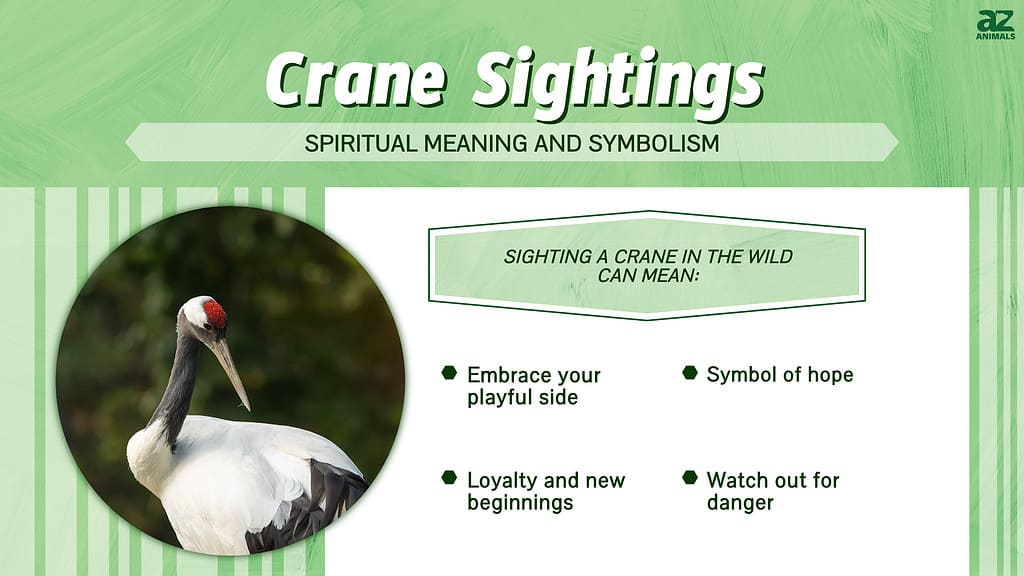
Did you see a crane soaring across the skyline? Crane sightings are a thrilling experience. This large bird species belongs to the family Gruidae, and they’re known for their long legs and necks. You can find cranes worldwide except for the Arctic and South America.
What does it mean when you see a crane fly by? The answer may surprise you. Along with bringing messages of new life and longevity, some cultures also see these birds as a cautionary omen. Follow along to learn about the spirituality and symbolism behind these amazing creatures.
15 Types of Cranes

The sarus crane is one of 15 crane species worldwide.
©Mukund Kumar/Shutterstock.com
What type of crane did you see? The exact species can help when uncovering symbolism and deeper meanings. There are 15 recognized species of cranes worldwide.
Here are the 15 crane species:
- Sandhill Crane (Antigone canadensis)
- Demoiselle Crane (Anthropoides virgo)
- Siberian Crane (Leucogeranus leucogeranus)
- Whooping Crane (Grus americana)
- Common Crane (Grus grus)
- Grey Crowned Crane (Balearica regulorum)
- Black Crowned Crane (Balearica pavonina)
- Wattled Crane (Bugeranus carunculatus)
- Hooded Crane (Grus monacha)
- Red-crowned Crane (Grus japonensis)
- Sarus Crane (Grus antigone)
- Blue Crane (Grus paradisea)
- Brolga (Antigone rubicunda)
- White-naped Crane (Antigone vipio)
- Black-necked Crane (Grus nigricollis)
These species vary in distribution and characteristics but share the crane’s distinctive features.
1. Embrace Your Playful Side
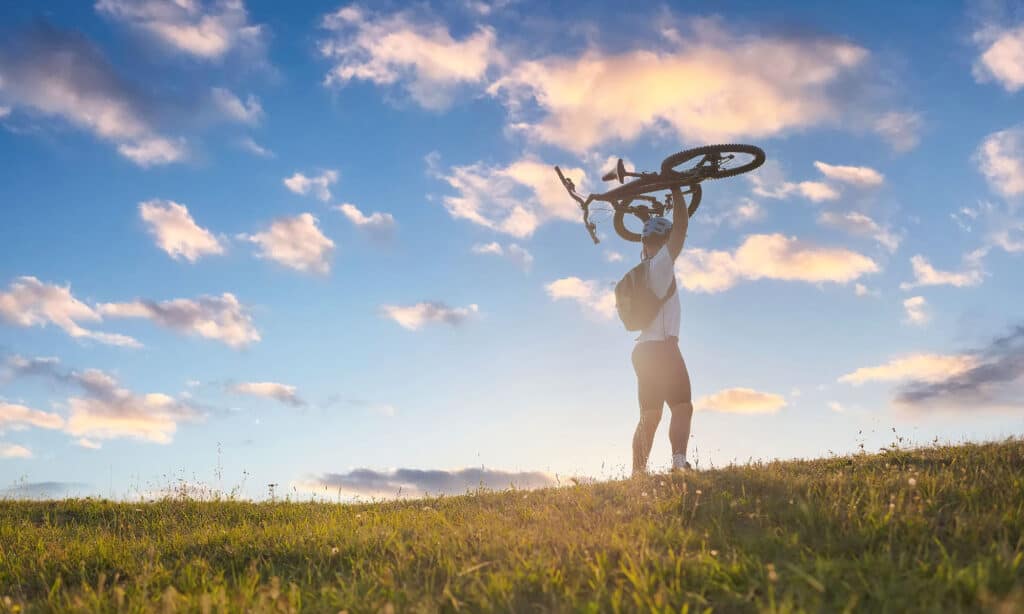
Seeing a crane can be a reminder to go outside and play.
©MalikNalik/Shutterstock.com
Everybody ages, but who says you have to feel old? Crane sightings can remind you to keep your spirit soaring high, defying the limitations of age. Go outside, ride a bike, walk a loop, or just lay in a field of flowers. Be like these graceful birds; stay playful and eternally young.
In Japan, the crane is a sacred bird associated with longevity and marital happiness. And giving a gift depicting a crane with a turtle signifies a wish for a long, healthy, and happy life.
Cranes are also revered in Korean culture, symbolizing eternal youth and peace. Other mythology associates cranes with eternal youth and immortality, while they represent unconditional love and good fortune in India. Finally, Native American tribes consider cranes sacred, using their feathers in spiritual ceremonies.
Cranes are often seen as protectors, representing grace, lifelong relationships, and the pursuit of new experiences. By embodying the qualities of the crane and keeping our minds and hearts young, we can approach life with a sense of child-like wonder.
2. Symbol of Hope
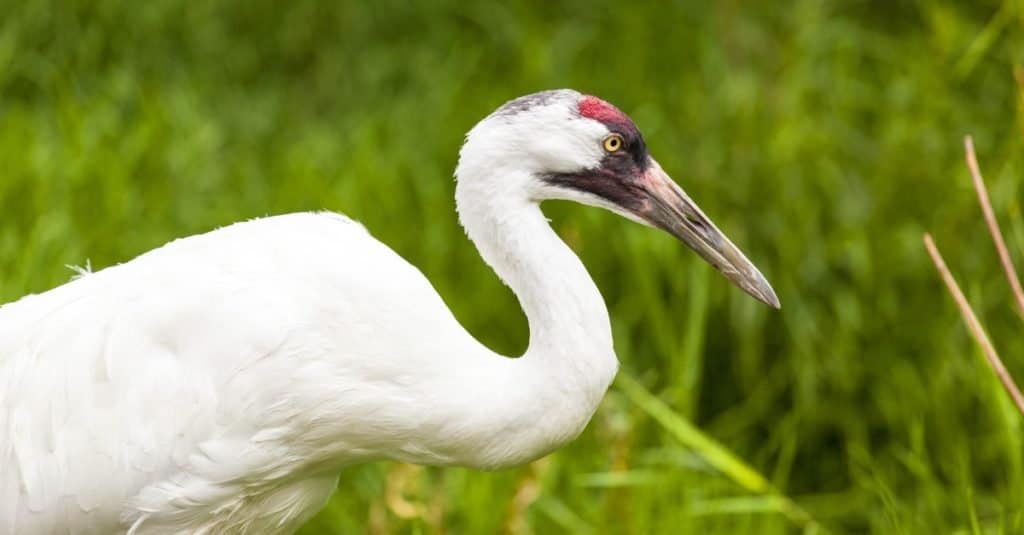
The whooping crane symbolizes hope thanks to its growing population.
©GTS Productions/Shutterstock.com
Have you had the privilege of spotting a whooping crane? These magnificent birds embody a symbol of hope that resonates on multiple levels.
There’s a remarkable story behind the whooping crane (Grus americana), one of the rarest bird species. At the lowest point in the mid-20th century, their population plummeted to mere 15 individuals. Things looked grim, but this species is hanging in there thanks to conservation efforts.
Today, the current estimated population of whooping cranes is around 800 individuals. If you see one, wildlife experts urge you to please report your sighting. The International Crane Foundation has a special map showing the last known sightings of whooping cranes. The data on the map comes from various sources, including remote transmitters, research partners, and even sightings reported by the general public like you!
There are two main populations of whooping cranes. First, there’s a migratory population, they breed in Canada and winter along the Gulf Coast of the United States. Second, there’s a non-migratory population in Florida. Both populations are tall birds, standing around 5 feet tall. Along with their height, these birds are easily recognized by their snowy white feathers, black wingtips, and vibrant red crowns.
Whooping cranes have a lifespan of about 20-30 years in the wild. They primarily feed on aquatic invertebrates, small vertebrates, and plants. When the mating season rolls around, these birds engage in an elaborate courtship display involving dancing, calls, and wing-flapping.
3. A Reminder to Dance

Cranes dance to communicate feelings, find a mate, or show aggression.
©Ondrej Prosicky/Shutterstock.com
Crane sightings can be the universe’s way of telling you it’s time to dance. This can mean breaking out with some dance moves or metaphorically finding a way to dance through life’s storms. Be okay with expressing yourself, no matter what it might look like.
Head bobbing, wing flapping, jumping, bowing, and twig tossing are just a few of these bird dance moves. Cranes dance as a way to communicate their feelings and intentions. These tall birds can convey different messages through a combination of movements, poses, and gestures.
Cranes dance to find a mate, strengthen their bond with a mate, show aggression, or claim territory. Thinking about or seeing dancing cranes might mean you need to reconnect with somebody important. They could also mean it’s time to defend what’s yours.
Cranes in Ballet
“Dance of the Cranes” aims to capture the essence and symbolism of cranes. The ballet, choreographed by Maurice Béjart, premiered in 1988. Since then, it’s been performed by various ballet companies worldwide. The dance emphasizes the beauty and artistry of crane-inspired choreography.
The ballet is inspired by cranes’ graceful movements and courtship dances, specifically the Japanese Red-crowned Crane. In honor of the crane’s grace, the choreography incorporates fluid and sweeping movements. It’s a true spectacle to see. The dancers mimic the elegance and beauty of cranes in flight. They even imitate the distinctive crane poses, such as elongated necks, lifted wings, and delicate bird-like footwork.
4. Watch Out for Danger
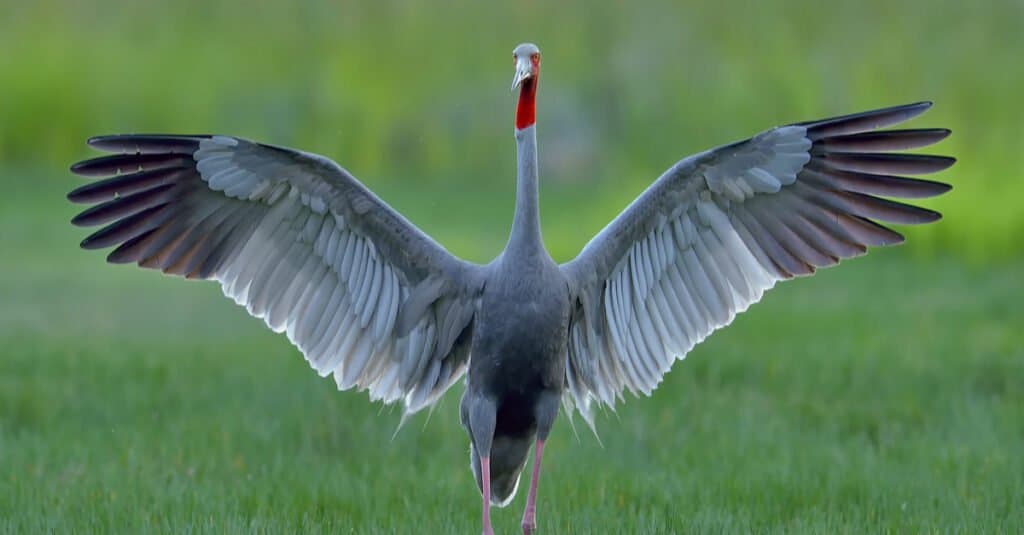
Seeing a crane can be considered a cautionary omen in certain cultures.
©vanchai/Shutterstock.com
The Greek word for crane is Geranos, and cranes were considered birds of omen in ancient Greece. Crane sightings can mean it’s time to be careful.
Crane mythology is found in various cultures and fables. The fable of the geese and the cranes from Aesop’s Fables highlights the cranes’ ability to escape danger due to their lightness and agility. There are also several styles of Chinese kung fu, including Wing Chun, Hung Gar, and Shaolin Five Animals, which draw inspiration from the movements of cranes.
5. Loyalty and New Beginnings
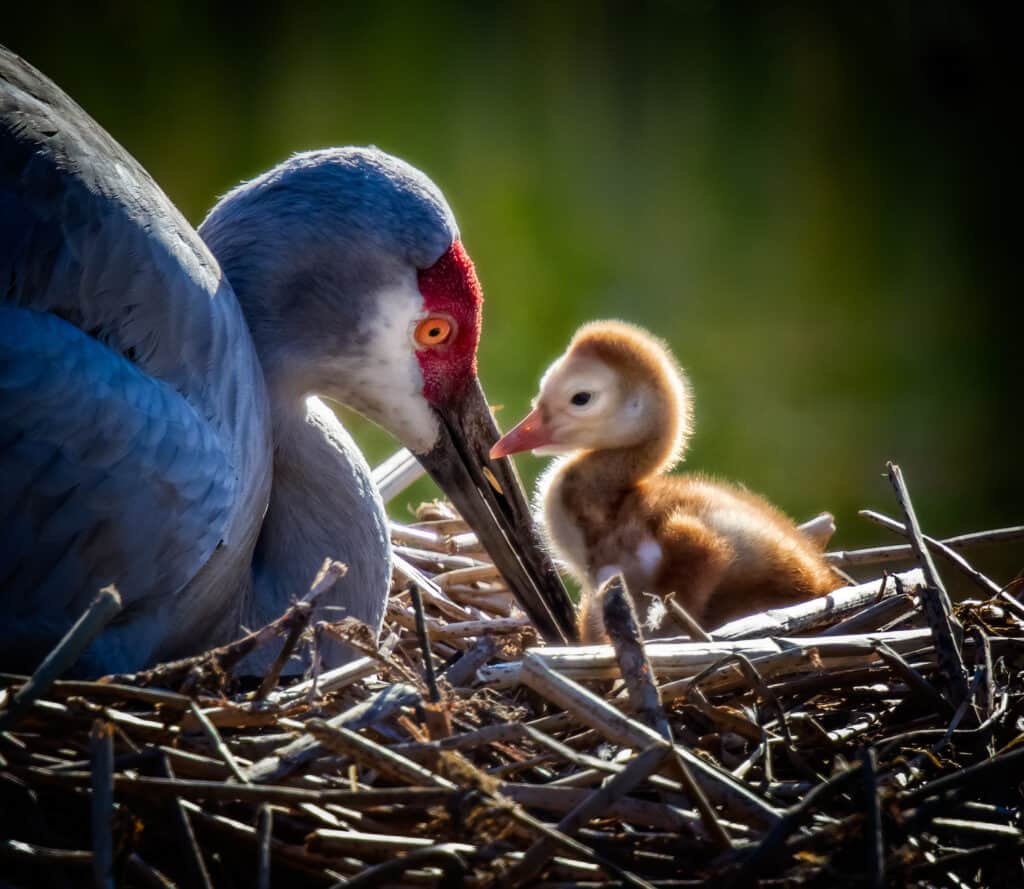
Cranes symbolize new beginnings in certain cultures.
©jo Crebbin/Shutterstock.com
Ancient drawings and carvings show us that cranes can symbolize friendship and being a part of something bigger than yourself. They also symbolize new life and opportunities. These findings are thanks to findings in Çatalhöyük, Turkey.
Çatalhöyük is a place in Turkey where there are two big mounds. One is called the Chalcolithic West Mound, and the other is the Neolithic East Mound. The East Mound dates back to around 7300-6200 BC. This place is famous because it has many houses made of mud bricks that are packed closely together. And inside these houses, they found paintings, carvings, and bird bones.
The artwork shows that cranes were important to the people there. They believed the tall birds had special meanings. They thought cranes represented living a long life, loyalty, and wisdom. The birds also likely symbolized good luck, happiness, and fertility. And that’s not all; drawings of other animals show that ancient symbolisms may have tied into a bigger story.
The artwork also shows that cranes were connected to other animals like cattle (cows) and canids (dogs or dog-like creatures). People believed there was a special connection between these animals. It’s like they thought these animals were all part of a special story or had a deeper meaning together.
Vulture Symbolism
If cranes represent new life, vultures take the opposite approach. Of all the bird bones found at Çatalhöyük, only 2% were from common cranes. The majority of the animal parts and drawings were all about vultures.
Vultures played a significant role in the ancient artwork found at Çatalhöyük. They were often shown in the paintings and carvings pecking at headless bodies. Sometimes the vultures were depicted with their heads mounted on walls. Vultures may have represented ideas related to death and the passage of souls.
Crane Self-Discovery Questions
Crane sightings are a personal experience. One person’s meaning won’t apply to the next. You have to do a bit of soul-searching and ask self-discovery questions to explore possible messages.
Feel free to explore these self-discovery questions without judgment:
- How did seeing the crane make you feel?
- Have you experienced any magical moments with cranes before?
- What mystical qualities do you associate with cranes?
- Where do you need balance in your life?
- Are you living in your truth?
There are no right or wrong answers; let your imagination soar. The fact you’re curious about what an animal sighting means is a sign you’re ready to discover something new. What will you find when you search your heart and soul? It may not be obvious now what you’re going after, but with time and patience, things can become clearer.
Crane Dream Interpretation

Pay attention to how you see cranes in real life to understand why you’re dreaming about them.
©iStock.com/cyano66
Did the crane’s presence evoke a sense of awe and wonder in your dream? Pay attention to the emotions that come up; they hold the key to understanding the deeper significance of your dream. Dream interpretations are rarely straightforward or logical. Instead, they’re all about how you feel.
Reflect on any previous encounters you may have had with cranes. Did you recently watch a documentary about these tall birds? Did you pass one on your way home? Take note of how these birds appear in your real life.
Whether it’s crane sightings in nature, daydreams, t.v. shows, start noticing when and how you’re coming into contact with these birds. This will help you understand what your subconscious may be trying to tell you. For instance, a crane dream could be a reminder to appreciate the beauty these birds have to offer.
Finally, crane dreams can also be a call to embrace your true self. If you’re not living in your truth, life will feel off and often heavy. But when you honor yourself, you can fly with grace and ease, as if on the wings of a lightweight crane!
History of Senbazuru: Folding 1,000 Origami Cranes
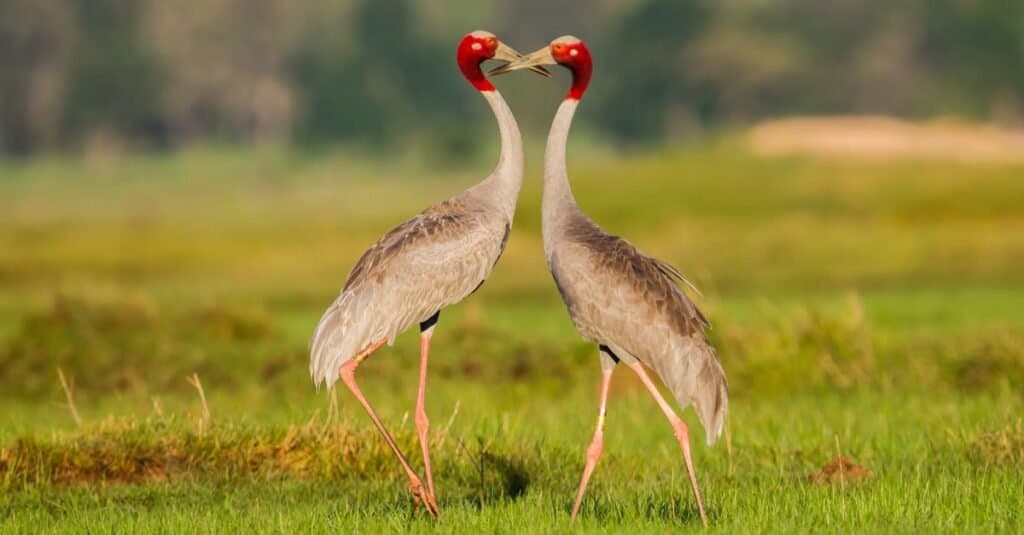
Senbazuru is a traditional Japanese origami artform involving folding 1,000 cranes.
©kajornyot wildlife photography/Shutterstock.com
Senbazuru is a traditional Japanese origami art form that involves folding 1,000 origami cranes. Legends suggest that if a person successfully folds all 1,000 origami cranes with a pure heart, their wish will come true. The legend’s origins are uncertain but are thought to be rooted in Shinto or Buddhist traditions.
Origami techniques were introduced to Japan from China in the 6th century. But folding 1,000 cranes became popular in Japan after World War II. The tradition became more widely known with the story of Sadako Sasaki, a young girl exposed to radiation in Hiroshima.
Sadako Sasaki began folding cranes with the wish to recover from her illness and bring peace to the world. While she did not complete the full senbazuru herself, the legend and her story inspired others to complete the cranes on her behalf. The senbazuru has since become a symbol of hope and healing. Many people fold the cranes with their own wishes and intentions in mind.
The Story of the Grateful Crane
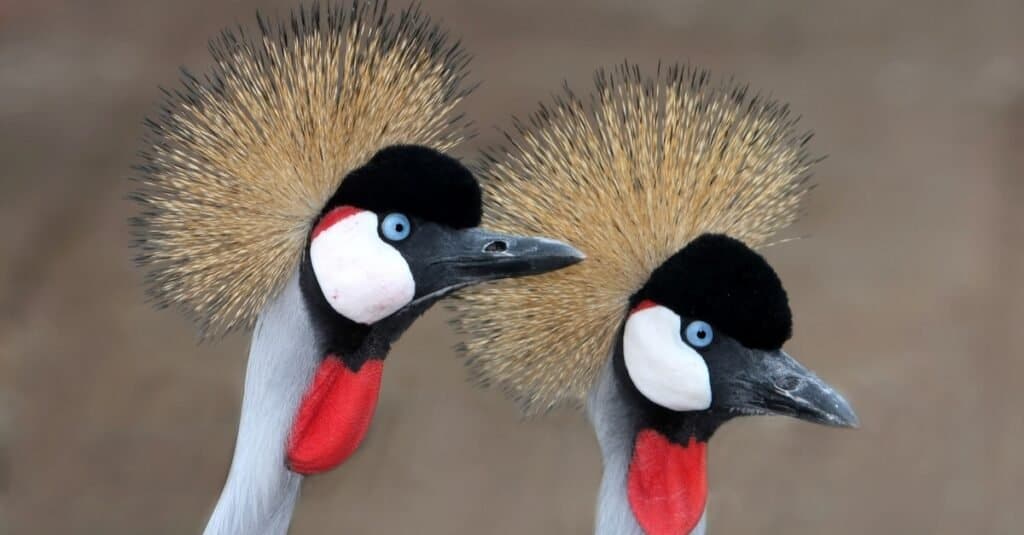
The story of the “Grateful Crane” teaches us about acceptance.
©Four Oaks/Shutterstock.com
Did you hear the Japanese folktale about the “Grateful Crane”? A poor farmer rescues a wounded crane, who turns into a beautiful woman that marries him. The couple faces financial difficulties when a harsh winter comes, but all is not lost. The wife weaves a cloth they sell for a large sum.
Sadly, when the farmer becomes overly curious and distrustful, he discovers that his wife is actually the crane he saved. After this discovery, she leaves him. The sad farmer lives alone the rest of his days, never marrying again.
What does this tale teach us? The “Grateful Crane” is about accepting things as they are. The farmer’s act of kindness in saving the wounded crane led to his good fortune. However, his curiosity and lack of trust ultimately lead to his unhappy ending. The story teaches us to be content with what we have rather than trying to change what is already beautiful.
Aesop Fable: The Wolf and the Crane

Aesop’s fable, “The Wolf and the Crane,” teaches us about avoiding shady characters.
©iStock.com/gnagel
In Aesop’s fables, animals take on human-like qualities, making it easier for us to connect with the characters. The cunning fox, or proud peacock, represents our virtues and flaws. Through their interactions, these characters offer us a mirror to reflect on our life choices. This is especially true in the famous Aesop fable, “The Wolf and the Crane.”
In the fable, a greedy wolf gets a bone stuck in his throat. He can’t remove the bone by himself, so he does the only logical thing and seeks out a crane for help. After all, cranes have super long necks and delicate, graceful movements.
The crane hesitates to help the wolf, so the desperate canine offers her a handsome reward. And this bribe is enough to motivate the crane to help out. Using her long neck and bill, the crane successfully removes the bone. However, when she asks for her promised reward, the wolf angrily refuses! He says that not being eaten by him should be reward enough. It’s a typical greedy wolf reply, leaving us with the moral that there isn’t a reward for helping bad guys.
Final Thoughts
Our journey through the world of crane sightings is at an end. Today we discovered that cranes aren’t just lovely birds with long necks; they hold deep cultural and spiritual symbolisms. From representing longevity and happiness to embodying hope and peace, crane symbolisms have resonated with humanity for centuries.
We also delved into the enchanting realm of crane dances. The ballet “Dance of the Cranes” beautifully captures the elegance and allure of these dances, showcasing the connection between nature and art. And speaking of art, we also learned about the ancient artwork at Çatalhöyük in Turkey. The ancient carvings and paintings display the importance of cranes as symbols of new lie.
And, of course, there’s the cautionary aspect of cranes. Ancient Greek culture associated these birds with the need for vigilance. So seeing a crane could be a sign you need to slow down and take stock.
Whatever your take-away is, one thing’s certain, cranes are incredible birds. Seeing one in the wild is a memorable experience you’ll never forget.
The photo featured at the top of this post is © Brian Lasenby/Shutterstock.com
Thank you for reading! Have some feedback for us? Contact the AZ Animals editorial team.







